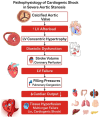Transcatheter Aortic Valve Implantation in Cardiogenic Shock: Current Evidence, Clinical Challenges, and Future Directions
- PMID: 40807025
- PMCID: PMC12348004
- DOI: 10.3390/jcm14155398
Transcatheter Aortic Valve Implantation in Cardiogenic Shock: Current Evidence, Clinical Challenges, and Future Directions
Abstract
Cardiogenic shock (CS) in the setting of severe aortic stenosis (AS) presents a critical and high-risk scenario with limited therapeutic options and poor prognosis. Transcatheter aortic valve implantation (TAVI), initially reserved for inoperable or high-risk surgical candidates, is increasingly being considered in patients with CS due to improvements in device technology, operator experience, and supportive care. This review synthesizes current evidence from large registries, observational studies, and meta-analyses that support the feasibility, safety, and potential survival benefit of urgent or emergent TAVI in selected CS patients. Procedural success is high, and early intervention appears to confer improved short-term and mid-term outcomes compared to balloon aortic valvuloplasty or medical therapy alone. Critical factors influencing prognosis include lactate levels, left ventricular ejection fraction, renal function, and timing of intervention. The absence of formal guidelines, logistical constraints, and ethical concerns complicate decision-making in this unstable population. A multidisciplinary Heart Team/Shock Team approach is essential to identify appropriate candidates, manage procedural risk, and guide post-intervention care. Further studies and the development of TAVI-specific risk models in CS are anticipated to refine patient selection and therapeutic strategies. TAVI may represent a transformative option for stabilizing hemodynamics and improving outcomes in this otherwise high-mortality group.
Keywords: aortic stenosis; cardiogenic shock; heart failure; transcatheter aortic valve implantation (TAVI).
Conflict of interest statement
The authors declare no conflict of interest.
Figures



Similar articles
-
Transcatheter management of left-sided valvular heart disease following heart transplantation.Eur J Cardiothorac Surg. 2025 Jun 3;67(6):ezaf191. doi: 10.1093/ejcts/ezaf191. Eur J Cardiothorac Surg. 2025. PMID: 40498548
-
[Transcatheter aortic valve implantation: a systematic review of the literature on efficacy and safety data].Recenti Prog Med. 2016 Jan;107(1):25-38. doi: 10.1701/2132.23102. Recenti Prog Med. 2016. PMID: 26901367 Italian.
-
Transcatheter aortic valve implantation for aortic stenosis in high surgical risk patients: A systematic review and meta-analysis.PLoS One. 2018 May 10;13(5):e0196877. doi: 10.1371/journal.pone.0196877. eCollection 2018. PLoS One. 2018. PMID: 29746546 Free PMC article.
-
Bicuspid aortic valve disease: advancements and challenges of transcatheter aortic valve implantation.Eur Heart J. 2025 Jul 21;46(28):2760-2775. doi: 10.1093/eurheartj/ehaf307. Eur Heart J. 2025. PMID: 40343748 Review.
-
Balloon-expandable Myval valve-in-valve transcatheter aortic valve implantation with bailout left main coronary artery chimney stenting: a case report.J Med Case Rep. 2025 Aug 5;19(1):390. doi: 10.1186/s13256-025-05471-0. J Med Case Rep. 2025. PMID: 40764583 Free PMC article.
References
-
- Hochman J.S., Buller C.E., Sleeper L.A., Boland J., Dzavik V., Sanborn T.A., Godfrey E., White H.D., Lim J., LeJemtel T. Cardiogenic shock complicating acute myocardial infarction--etiologies, management and outcome: A report from the SHOCK Trial Registry. J. Am. Coll. Cardiol. 2000;36((Suppl. S3)):1063–1070. doi: 10.1016/S0735-1097(00)00879-2. - DOI - PubMed
Publication types
LinkOut - more resources
Full Text Sources
Research Materials

